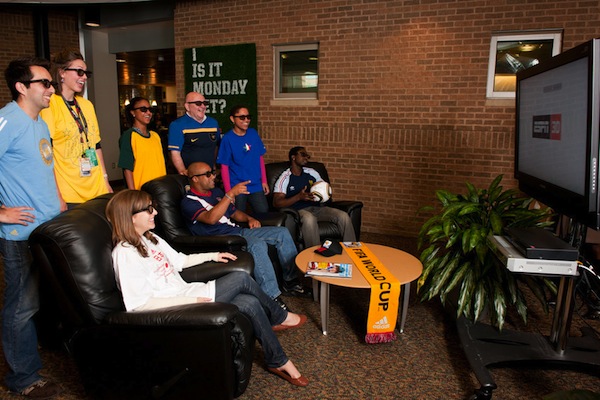 ESPN Research + Analytics announced the results of its latest 3D TV study, which concludes that viewers are comfortable with 3D and enjoy it more than HD programming.
ESPN Research + Analytics announced the results of its latest 3D TV study, which concludes that viewers are comfortable with 3D and enjoy it more than HD programming.
For more information visit: espn.go.com
Unedited press release follows:
 ESPN Announces Results of Comprehensive 3D Study
ESPN Announces Results of Comprehensive 3D Study
Continuing to innovate in the 3D television space, ESPN Research + Analytics unveiled today one of the most in-depth studies on 3D TV to date. Compiling results from more than 1,000 testing sessions and 2,700 lab hours, ESPN has concluded that fans are comfortable with the medium and even enjoy it more than programming in HD. The research was conducted by Dr. Duane Varan, professor of New Media at Murdoch University, during ESPN’s coverage of the 2010 FIFA World Cup at the Disney Media and Ad Lab in Austin, Texas.
The research employed an experimental design approach including the use of perception analyzers, eye gaze and electrodermal activity. The study focused on a multitude of topics including overall viewing enjoyment, fatigue and novelty effects, technology differences, production issues and advertising impact. In all over 700 measures were processed during the testing. The Ad Lab used five different 3D manufacturers in its testing.
“The results from this comprehensive research project support what we have said time and time again – fans have a higher level of enjoyment when viewing 3D. Plus, for advertisers, this study provides good news on the level of fan engagement when viewing 3D ads,” said Artie Bulgrin, senior vice president of ESPN Research + Analytics. “This study will help us continue to develop ESPN 3D as an industry leader for event-based 3D viewing.”
Key Findings:
3D TV ads can be more effective
• In testing the Ad Lab showed viewers the same ads in 2D and 3D. 3D ads produced significantly higher scores across all ad performance metrics – generally maintaining a higher level of arousal than the 2D counterpart.
• Participants showed better recall of the ad in 3D:
– Cued recall went from 68% to 83%
– On average, purchase intent increased from 49% to 83%
– Ad liking went from 67% to 84%
Fans enjoy 3D
• The results showed a higher level of viewer enjoyment, engagement with the telecast and a stronger sense of presence with the 3D telecasts.
– Enjoyment increased from 65% to 70% in 3D while presence went from 42% to 69%
Passive vs. Active
• With all things equal, there were no major differences between passive and active 3D TV sets for overall impact however, passive glasses were rated as more comfortable and less distracting by participants.
Depth Perception
• The study found that there were no adverse effects on depth perception (stereopsis).
• It appeared that there is an acclimation effect whereby participants adjust to 3D over time under normal use.
True 3D vs. 2D
• Participants showed much more favorable responses to true 3D images than to 2D.
About the ESPN 3D Research Study
Conducted over the course of the 2010 FIFA World Cup, this is one of the most ambitious studies of 3D viewing to date. Participants were tested prior to 3D viewing, in test and post test to garner a wide range of information. Testing was completed at the Disney Media & Advertising Lab which was developed to better understand the emotional drivers of audience behavior and physiological reactions to advertising. The facility conducts year-round tests using the most advanced research techniques including biometric measurement tolls to evaluate engagement and emotional responses. This research was conducted by Professor Duane Varan, Executive Director and Chief Research Officer of the Disney Media & Advertising Lab, and his staff. Varan is recognized as a global innovator in iTV applied research and as one of the foremost authorities on new media. He is the Executive Director of the Interactive Television Research Institute and holds the inaugural chair in New Media at Murdoch University in Perth, Australia.